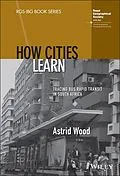How Cities Learn traces the circulation of bus rapid transit (BRT) to understand how and why it was widely adopted in South Africa.
* Investigates the global proliferation and localization of BRT
* Examines the production and distribution of transportation knowledge in the global south
* Addresses the spatial and social legacy of apartheid in South African cities
* Reveals a new way of understanding the intersections between policy, people and place
* Essential reading for scholars of geography, politics, sociology and transportation, as well as urban planners and practitioners
Autorentext
Astrid Wood is an Assistant Professor in the School of Geography, Politics and Sociology at Newcastle University, UK. Dr. Wood is an urban geographer specializing in infrastructure, governance and transportation.
Klappentext
'This carefully written and researched study offers detailed analysis of South African cities' uneven implementation of bus rapid transit systems. Scholars who participate in the lively global conversation on urban policy will find much to contemplate within this thoughtful book.
Garth Myers, Paul E. Raether Distinguished Professor of Urban International Studies, Trinity College, Hartford
'Urban problems are becoming increasingly complex requiring the actors and institutions of governance to continually learn, adapt and innovate. But how does this learning happen? This book provides an extraordinary case study. It describes with uncommon clarity an intricate process of policy transfer involving global actors and circulations but also embedded local concerns, politics and governance arrangements. It is essential reading for urban scholars and public policymakers.'
Philip Harrison, South African Research Chair in Spatial Analysis and City Planning, University of the Witwatersrand, Johannesburg
In 2006, South African policymakers were captivated by a new concept. Bus rapid transit (BRT) promised to be a quick, cost-effective and efficient method of urban transportation that combines the speed and quality of rail with the flexibility of a bus system. Three years later, Johannesburg's Rea Vaya opened as the first BRT system in Africa, with Cape Town's MyCiTi becoming operational two years later. Since then, Ekurhuleni, eThekwini, Nelson Mandela Bay, Rustenburg and Tshwane also launched BRT. While these South African systems are unmistakably modeled after the pioneering qualities of BRT in Bogotá, the process through which South African policymakers learned of and implemented BRT remains unexplored. In tracing this learning process, How Cities Learn considers how and why policymakers adopt best practices. This book is essential reading for scholars of geography, politics, sociology and transportation as well as urban planners and practitioners.
Zusammenfassung
How Cities Learn traces the circulation of bus rapid transit (BRT) to understand how and why it was widely adopted in South Africa.
- Investigates the global proliferation and localization of BRT
- Examines the production and distribution of transportation knowledge in the global south
- Addresses the spatial and social legacy of apartheid in South African cities
- Reveals a new way of understanding the intersections between policy, people and place
- Essential reading for scholars of geography, politics, sociology and transportation, as well as urban planners and practitioners
